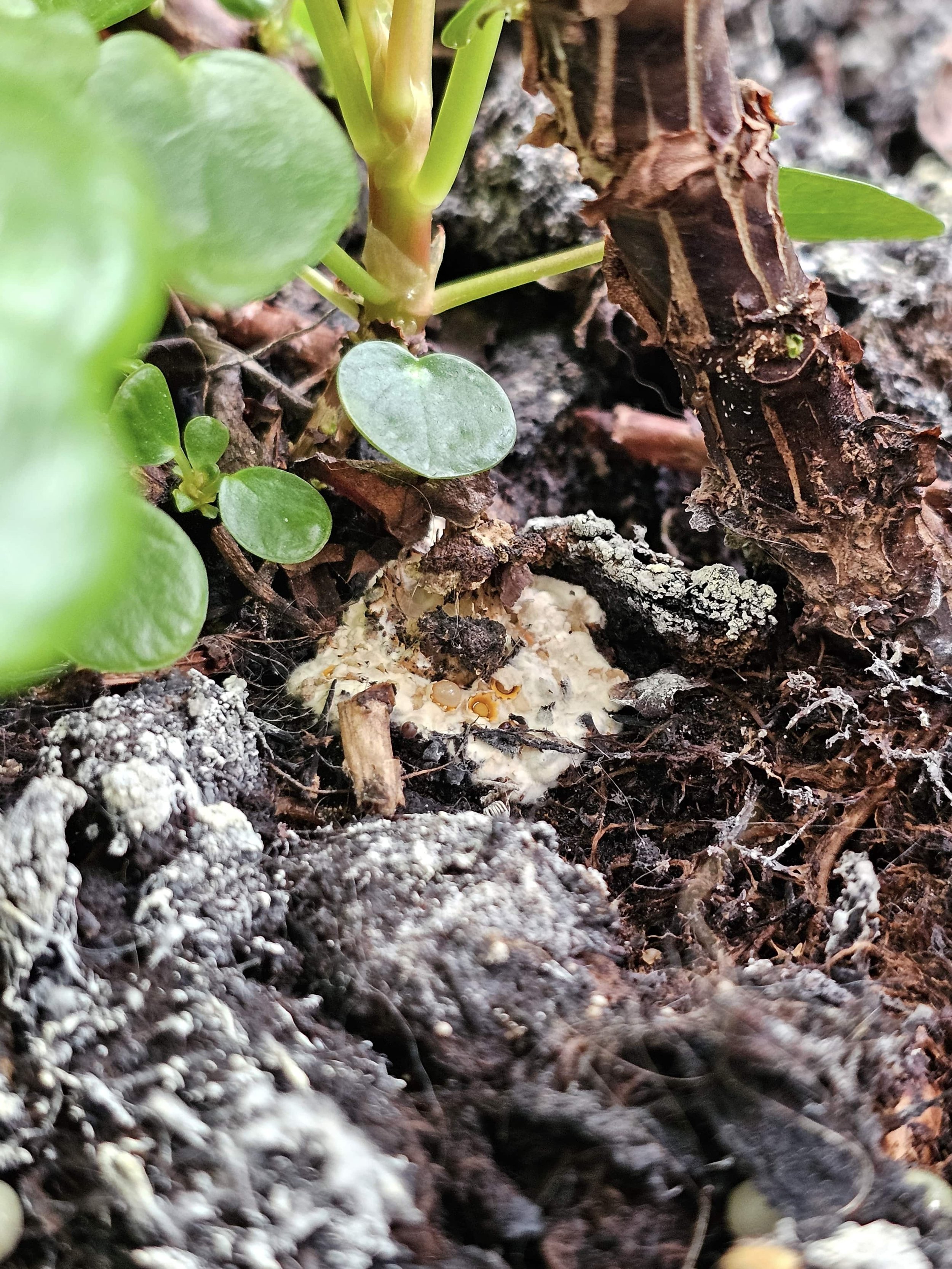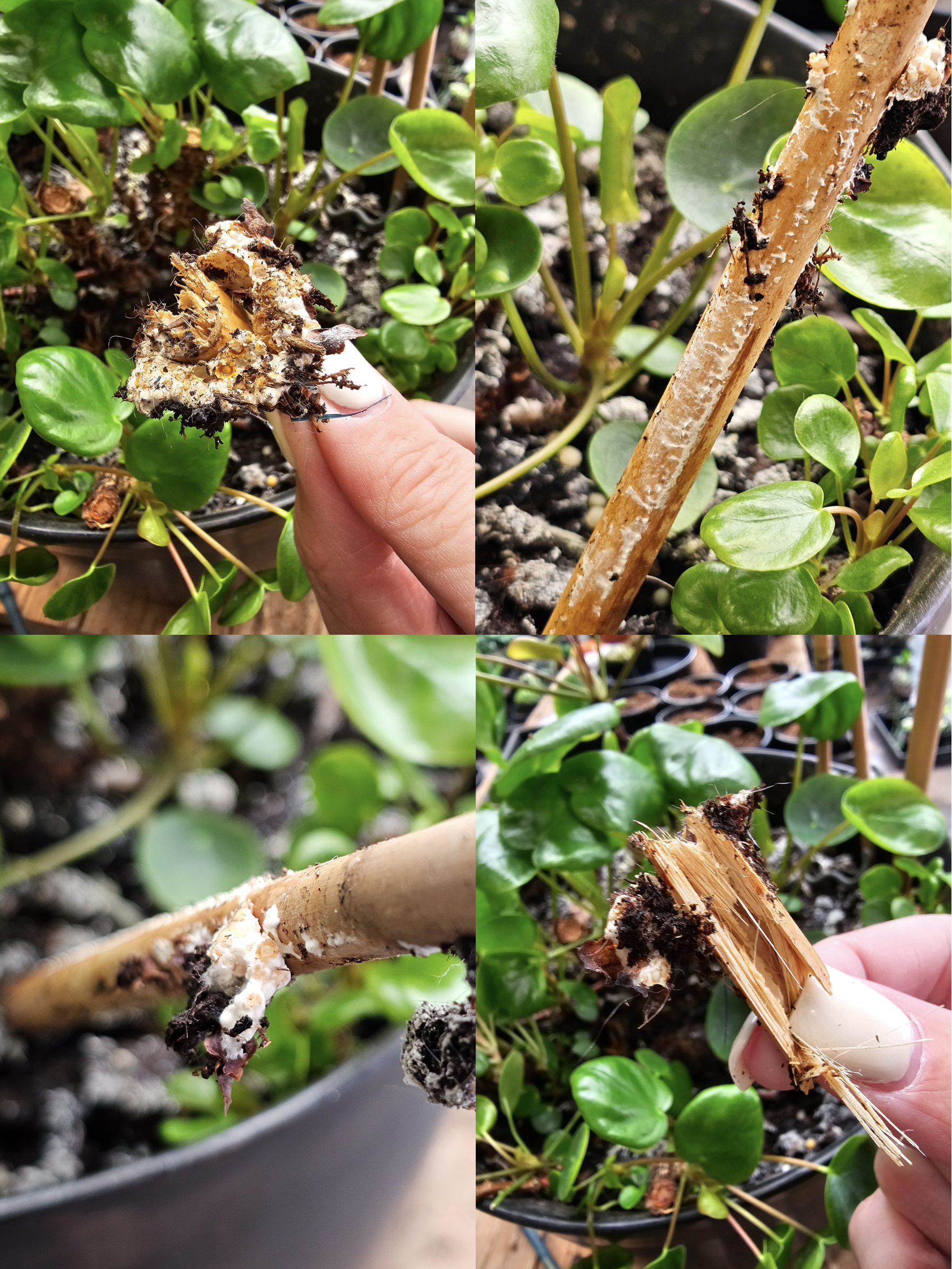What is 'Artillery Fungus' and Why You Should Care
Artillery Fungus on a broken stake at the base of a Pilea plant
Did you know that Fungi in your indoor plant’s soil can actually be a good thing and not something that needs to be immediately removed or concerned by? This is because fungus will only grow in rich and healthy soil environments so is therefore a sign that your soil is thriving and not ‘infected’ or needing replacement. Most common household plant fungus will not harm your plants, or you, and is happy to share its home in a symbiotic relationship with your plants. Unfortunately, however, there is one fungus that will cause issues to your home if it appears in your soil, this is ‘Artillery Fungus’. Let’s explore two common unharmful fungi found in your plants, and then look at why Artillery Fungus is altogether different.
WHY DOES FUNGUS GROW IN MY SOIL
Trichoderma growing on Peat
Firstly, lets have a look at why fungus of all kinds grows in your soil and why different soils attract different kinds of fungus. Under the right conditions, all potting soils can attract and grow a thriving community of fungi. It is a sign the soil is warm, damp, dark and nutrient dense, which on the surface is not a bad thing! Peat moss is a very rich growing environment, which is why plants grow and thrive in it so well. Fungus is no exception and in the right conditions, two main types of fungus are commonly found growing on or around indoor plants, especially those potted in nutrient rich peat moss. These are Trichoderma and Leucocoprinus birnbaumii.
Trichoderma is a naturally occurring micro-organism that is beneficial to, and lives in, most soils. It is white and looks like a fine layer over the top of the soil under the canopy of the plant. The main benefit of Trichoderma as a beneficial fungi in your soil is that it inhibits the prolific growth of pathogenic fungi. It is an indicator that your soil is not too acidic or alkaline in Ph, as it would not grow otherwise, likes a warm temperature range, likes access to moisture and grows better in low ventilated areas. It is in no way harmful and can be left alone, however can be scraped off and thrown away for aesthetics if you wish. Plants that remain moist longer in the soil are more likely to have Trichoderma growth, however in healthy peat soils, it can be seen on many plants top soil. Trichoderma can actually be introduced to other types of soil as an organic benefit to prevent disease and pathogenic issues in the root systems of plants.
Leucocoprinus birnbaumii Lifecycle - Image by Vik Nanda
Leucocoprinus birnbaumii is sometimes called the ‘yellow houseplant mushroom’ due to its yellow colour, and appears like tiny yellow balls on the soil. It is common on indoor plant soils hence the name, and is more likely to appear in soil which is moist with low air flow and in lower light, even in the drainage holes of nursery pots. Moving a pot to a brighter position, letting the soil dry out and increasing airflow will reduce or eliminate this fungus as the growing conditions are no longer favorable. Leucocoprinus birnbaumii lives in the soil, and not on the plant so is of no harm to the health of the plant itself. Again, it is a sign that the soil is healthy, allowing the fungus to thrive. As can be seen in the image the fungus develops and grows little yellow fruiting bodies, or mushrooms, which will die off at the end of the lifecycle, before more develop. These mushrooms are known to be mildly toxic when ingested by animals or humans however so are best removed if you have curious young ones or perts in your home. If not, they can be left to complete their lifecycle without issue.
Both Trichoderma and Leucocoprinus birnbaumii are of saprophytic origin meaning they only consume decaying biological material. This means their presence on your soil is not harmful to you or your household, or indeed the plants themselves. It can however mean that your plant, depending on the variety and the soil, is too wet in the soil, needs more air flow or, most commonly needs more light. For example, wet potting mix contains decomposing pine bark or orchard bark which the fungus will happily feed on, but could be leading to root rot in your plant. The appearance of these two common fungi should give you reason to asses the health of the plant itself just incase the fungus is a symptom of something wrong in the care and/or position of your indoor plant.
WHAT IS 'Artillery Fungus'
Artillery fungus growing on a decaying bamboo stake
As with the above common fungus, Artillery fungus, or Sphaerobolus, likes a damp environment to thrive and also feeds on biological material. The main differences however is that it prefers a cool temperature to thrive, 10 to 20 degrees Celsius, feeds on decaying wood or dung, and likes a bright environment to grow and thrive. This in itself makes it more common and likely to thrive in indoor plants that are in a bright position, in a bark potting mix, that like water. It also means Artillery fungus is common in damp outdoor environments of temperate regions that have decaying material like wood chip mulch, especially in a sheltered position for example near a wall or home. In a peat potting media, Artillery fungus does not have the required decomposing wood or dung to feed on, however repotting or mixing a pine bark plant into peat, or placing a wooden stick or bamboo stake into the soil for a plants support can easily lead to favourable conditions. Wood, including bamboo and bark, will break down over time leading to the decaying wood material required for Artillery fungus to grow.
“The fruiting body propels its spores, or Peridiole, into the air in the direction of the most light. Each fruiting body can shoot its Peridiole up to 6 meters!”
Peridiole spores attached to a wall
Artillery fungus begins as a thick pale yellow carpet like growth around the decomposing material, which can sometimes be under the soil and not seen as easily. When ready it produces fruiting bodies which look like small yellow flowers on the surface of the soil. These fruiting bodies fill with fluid as they mature, building up pressure, until they burst open. A few hours after this occurs, the fruiting body propels its spores, or Peridiole, into the air in the direction of the most light. Each fruiting body can shoot its Peridiole up to 6 meters! This 2mm small black and spherical Peridiole is covered in a sticky coating allowing it to stick to the surface it lands on. This surface is commonly pale in colour, such as white, cream, lemon yellow etc, as these colours and shades reflect the most light. If conditions are favourable, these ejected spores will grow continuing the lifecycle of the fungus. You can see now why Sphaerobolus has the common name Artillery fungus as it shoots its spores like artillery rifles shoot their bullets! So why then is this fungus, that feeds on decaying wood and dung not the indoor plant itself, so annoying and require removal when found in your plant?
Artillery fungus thriving in and around a decaying bamboo stake, nowhere else on or in the peat soil
WHY IS 'Artillery Fungus' BEST REMOVED
The presence of Artillery fungus in your indoor plants is a sign wood in your plants pot is decaying. No matter the source of the wood, its decay is feeding the fungus which will spread throughout the soil. Artillery fungus itself is not harmful to the plant as, like other indoor plant fugus, it does not interact in a negative way with the plants roots or growth, however as with other fungus, it can be a sign the plant is too wet which can lead to root rot at some stage. Letting the soil dry out will improve the presence of the Artillery fungus but removal of its ability to feed is a guarantee. Repotting into a non bark based soil, like peat moss, removing wooded and bamboo stakes from the soil and letting the soil dry between waters are all more likely to result in a plant free of Artillery fungus. Indoors this is so important not for the health of the plant, but for your walls and surfaces!
The Peridiole is a container full of spores of the fungus. To ensure it keeps the spores in a favourable, light filled environment, this Peridiole is coated in a sticky glue like substance. If the Peridiole is left on the surface, this glue hardens making it difficult to remove. You can scratch the outer coating away to reveal the light bundle of spores inside, however the section of the Peridiole touching the wall or surface will leave a small black stain. The longer the bundle sits of the surface, the darker and more difficult to remove the stain becomes. The Peridiole will scrape off the surface if gotten to in the first week or two quite easily and you can then clean any remaining stains off the wall with a hot water and soap solution. If a non porous surface is where they have attached, a bleach and water cleaning option can be effective too, but be careful to to bleach a porous surface. If left in the soil however, these Artillery fungus will continue to grow, fruit and project their spores onto your surfaces. For your home this means a greater and greater chance of small black dots all over your walls and roof. Eventually it may mean cleaning and repainting your surfaces covered in tiny dark spots, which is annoying to say the least!
To be safe, if you notice these small dots on your walls and roof, check your plants within a 6 meter radius for Artillery fungus and remove it. This may mean replacing the soil to ensure it does not grow back, or simply removing a rotting bamboo stake, and therefore the food source of the fungus.
prevention is better than cure
As with anything, prevention of issues like Artillery Fungus is far easier than a cure. Making sure that your soil is not too wet, changing to a non bark based soil, using metal or plastic stakes for long term use and removing any wood product that is soft and/or decaying is best. Like with pests in plants, there is no way to ensure that you never have a fungus of some sort growing in your soil a they go hand in hand. Taking steps to prevent Artillery Fungus however, means any fungi friends you may acquire will not harm the surfaces of your home!
Remember, fungus growing around your indoor plants is not necessarily bad in itself but can be a sign something is out of balance for your plant. Once that is checked off, you can be safe in the knowledge that your soil is healthy and growing multiple happy plants. Just make sure you remove the Artillery fungus or live with the resulting polkadot walls.
Happy Growing!






